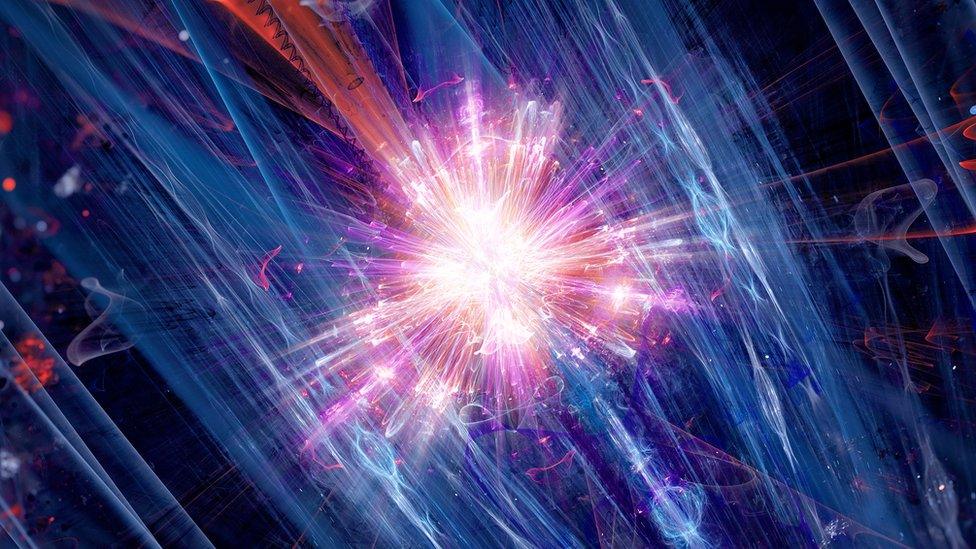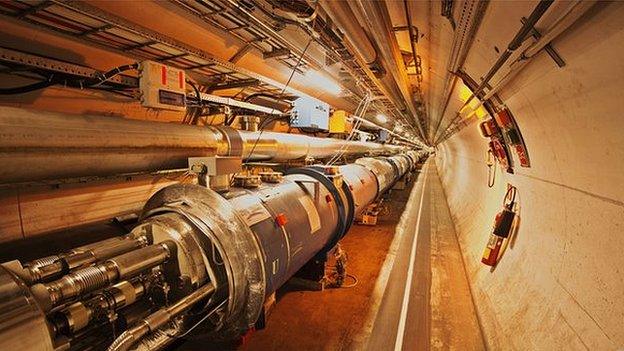The Large Hadron Collider: The world's biggest science experiment restarts
- Published
- comments

The Atlas detector is one of four instruments at the LHC trying to find particles completely new to science
Deep underground on the border between France and Switzerland is the Large Hadron Collider (LHC) - the world's biggest science experiment that aims to unlock the secrets of the universe.
The collider is a particle accelerator, a long, huge tube built over ten years between 1998 and 2008 - it sits 100 metres underground in a 16 mile (27km) ring tunnel and studies tiny particles created by atoms crashing together inside it.
The Large Hadron Collider was responsible for one of the biggest and most important breakthroughs in science this century, the discovery of the Higgs boson - something that has helped scientists understand how the universe works.
Martin went behind the scenes to find out more about the Large Hadron Collider
The Higgs boson discovery revealed the secret of what gives everything its mass - that's a measure of how much 'stuff' is inside an object such as particles, people or even planets.
After being turned off in 2018 the machine has been given a major upgrade and is being turned back on for more experiments; trying to find more particles that are completely new to science.
Dark matter

This computer simulation shows dark matter (in purple) spread across the universe. LHC researchers hope to find it for real
Dr Marcella Bona monitors experiments at CERN, the European Organisation for Nuclear Research that is home to the Large Hadron Collider. She says one of the things the team is about to look for is something known as dark matter - in what could be one of the biggest scientific discoveries, ever!
"We are looking for lots of new phenomena, dark matter for example.
"It is the majority of the universe that is made of this dark matter. At the moment [we] have no clue what it is, so absolutely that would be incredible!"
So what's the LHC actually looking for? Professor Tim O'Brien from the Jodrell Bank observatory says physicists are hoping it'll give clues about dark matter
Since the 1930s, scientists have been aware of dark matter which is present across the blackness of space.
Stars and planets are a small fraction of what is in the universe and dark matter, which is invisible, fills most of the gaps in-between.
Experts became aware of phenomenon existing because it has its own gravitational pull, but there are lots of mysteries about what it actually is.
We've worked for the past three years updating the machinery. Now we are ready.
Now, scientists at CERN want to create dark matter particles by accelerating atoms close to the speed of light inside the collider, before smashing them together.
And the machine's upgrade makes new discoveries from the experiment all the more likely.
"It is going to be two to three times better, in terms of the ability for our experiment to detect, collect and analyse data," says Dr Bona.
"We've worked for the past three years updating the machinery. Now we are ready."
Fifth force of nature

The Large Hadron Collider fires particles together at incredible speeds
Experts also hope research at the LHC will prove the existence of a fifth force of nature.
Gravity, electromagnetism and two nuclear forces are the four forces that physicists currently know about.
"I've been hunting for the fifth force for as long as I've been a particle physicist," says another researcher, Dr Sam Harper.
"Maybe this is the year".
- Published3 June 2015

